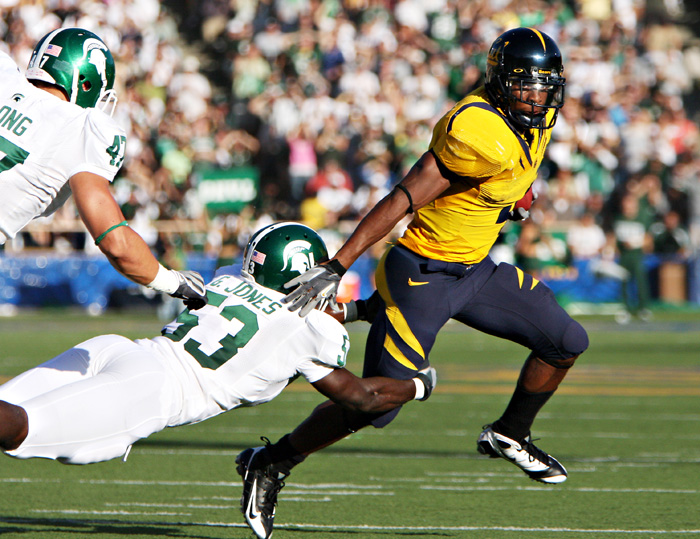Use aperture priority. Why? In dynamic lighting situations (which will be anywhere outdoors), your lighting will be all over the place as the sun starts to decline, clouds roll in, and players move in and out of shaded regions (or for stadium lighting, the better-lit sidelines). There is simply no way to manually adjust the exposure parameters, even if you can think quickly enough to know which settings to switch to.
Use the largest aperture. This goes almost without saying – you want to isolate your subjects in sports photography, and the best way to do that (given a certain camera/lens setup) is to use a wide-open aperture. This also has the advantage of letting in as much light as possible. The margin of error for focus *will* be thinner, but this really shouldn’t be an excuse or barrier to return inferior shots taken at smaller apertures just because it’s easier. Take the out-of-focus shots as they come – every ruined shot should just be an incentive to learn how to effectively track subjects and utilize your camera’s AI Servo/continuous focusing abilities.
Maintain a fast shutter speed in the shaded region. The goal here is to have a fast enough shutter speed to avoid blur, and with your aperture stuck at wide-open, you’ll do that by manipulating your ISO sensitivity. Since you’re shooting in a situation with dynamic lighting, you want to choose the ISO that will give you the necessary speed in the darkest area (i.e. in the shaded portion of the field, or when a cloud rolls by and blocks the sun). If you’re maintaining a decent enough speed in the dark areas (say 1/500s), then you’re guaranteed to get a decent speed in any other area, since it’ll be brighter (if you’re getting 1/500s in the shade, you might get 1/2000s in the sun). Does this mean you’ll be using a higher-than-necessary ISO when you’re in the brigher areas? Yes (if you’re getting 1/2000s in the sun, that means you could drop the ISO 2 stops and still get your 1/500s minimum). However, the noise is going to be a minor problem at the lower ISOs where you might deal with this half-lit, half-shaded situation (the difference between ISO100 and ISO400 is virtually indistinguishable), and in any case you’re only over-using high-ISO in the brighter area, where your noise is going to be less (due to greater amount of light) than whatever you’ve already accepted putting up with in the darker area.
The real important point here is that at all costs, you want to avoid slow shutter speeds, since blurred out pictures are completely unusable and unsalvageable, while most agencies (and any skilled photoprocessor) can put up with a relatively huge amount of noise. So take the noise hit in the brighter situations (which is not going to be that much) if it will help you get rid of blur in the darker regions (which is going to be a huge problem)
Keep track of your shutter speeds as lighting dims. Over the course of a late-afternoon to evening game, the sun is going to set and you’ll gradually see light levels drop, and concurrently, the need for longer shutter speeds and higher-ISOs to compensate. If you’ve got some sort of auto-ISO feature on your camera that helps to maintain a specified shutter speed by adjusting the ISO, use it. Otherwise you’ll have to monitor your shutter speeds as the game goes along and bump up your ISO periodically as you see the shutter speeds dip below the motion blur threshold you want.
Consider center-weighted metering with dynamic secondary elements. In most situations, the default evaluative/matrix/segmeneted metering mode on the camera will do a fantastic job of determing correct exposure. Where these metering modes often get confused is with highly dynamic secondary elements in the image – very dark shadowed stands in the background, or very bright field in the foreground of a shadowed area. This throws off the metering and makes the camera think the scene is darker or brighter than it really is in situations like rolling clouds or sunset, where the field (or parts of it) may rapidly become lit or unlit. The solution for this is to use a center-weighted metering mode that will bias the exposure towards your selected subject. This way things like a dark background or very bright foreground won’t have any effect on exposure – the camera only looks at your primary subject and determines the correct exposure for that, which is all we care about. Of course, the potential danger in this is that an athlete’s dark or white jersey will similarly throw the camera’s metering off – the best compromise is probably to use a broader center-weighted focusing mode, such as partial metering or center-weighted average, to include more of the surrounding area and balance out extreme variations.
This is part 2 of 4 in Football Photography X’s and O’s, a 4-part series of insights on shooting football.
Part 1: Equipment Analysis 1 (Michigan State game)
Part 2: Aperture-priority Exposure Technique
Part 3: Lighting Situations
Part 4: Equipment Analysis 2 (Washington State game)



